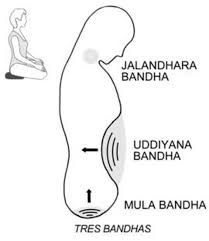 Yin and Yang Side of Bandhas I wanted to discuss the Yin and Yang side of bandhas; very beneficial not just to our yoga practice, but our everyday life. This is especially important for people with lower back issues. So, you may wonder why talk about bandhas? What are bandhas? They are body locks in key points in our bodies where prana (breath), our life force and energy are present. Prana is the upward lifting energy in our spine. Apana is descending energy in our spine. This actually prompts our lungs to breath as two energies flow together. This stimulates the nervous systems and optimizes circulation throughout our bodies. Bandhas are contracted by specific muscles groups. When we engage the bandhas it directs the prana into the nadis. Nadis are pathways which translates to “little rivers.” Some ancient text, Shiva-Samhita claim there are 350,000 nadis. Upansihad tells us they are countless, especially in our Yin poses where we slow down the breath and relax into the pose. We know the importance in our active Vinyasa practice where the bandhas and breath are key to our practice. However in Yin where we hold the poses for long periods of time, it is equally important, in a different way. Let me explain: As we fold forward, we can engage (perineum) Mula Bandha and Uddiyana (abdomen) upward motion. This brings the pose to new level,as you become actively engage with the breath and bandhas. Bandhas exercise I invite you to try this while inhaling on four second count breath. Engage your root lock and then relax it while you exhale slowly on a four count breath. Keep this count/breath active as you hold your poses in Yin. In Yang classes the poses move more quickly and the bandhas are continuously engaged. The third lock lock is Jalandhara (neck/chin). Paul Grilley states, “Keep the Glottis open when performing jalandhara bandha as we fill our lungs with air.” We want to maintain a sense: as if we are sipping small amounts of air, however we are not actually inhaling deeper. The breath is a normal rhythm. The general feeling is that jalandhara bandha will control the flow of breath/prana in the neck area. See if you can visualize Apana as the breathing of downward rooting energy. Apana is most easily felt during exhalation. Close your eyes and feel the energy as you inhale Prana up your spine. Hold the breath for a second or two. On the exhale visualize the Apana energy coming down to the base of your spine. Remember with each inhale to engage all three bandhas, hold, then release as the breath travels down your spine. Uddiyana Bandha The Uddiyana is praised above all others in most circles. Pattabhi Jois defines the Uddiyana Bandha as "Lifting the core muscles four inches below the navel". To engage this bandha we contract the abdomen above and below the navel and toward the back”. In active Yang practice the lower abdomen should be drawn in and held tightly. This protects the lower back. We find when bandhas and breath are employed correctly the pose comes alive! Bandhas are meant to be held, lock or tighten. BKS Iyengar states “Bandhas are safety valves that should be kept close while practicing Kumbhaka ( retaining or holding the breath with either the lungs, full or empty). Rechaka (breathing out) Both should be done as slowly as possible on a four to six count cylcle.” If you are not quite sure how to engage Mula Bandha, think of doing a Kegel exercise. The benefits of Mula Bandha include stimulation pelvic nerves, toning of the gentile organs and overall improvement of internal organs health. When you are using bandhas in your Yin class be aware to be subtle. Where as in a Yang class you are fully engaged. When in Yin Yoga just engage your bandhas about 15- 20%. With this subtle engagement it will actually help to hold our awareness in your pose. Of course this is also true in a Vinyasa flow practice. The main difference is the bandhas are engage 75-100%. Try this at your next yoga class, notice the difference! One more point to keep in mind is Vyana -Vayu which is the outward-moving energy which is part of prana. Vyana is situated in the heart and lungs and flows throughout the entire body. The flow of Vyana-Vayu moves from the center of the body to the periphery. It governs circulation of all substances throughout the body and assists the other Vayus with their functions. To experience Vyana-Vayu: Close your eyes, sit or stand with a long spine and relaxed body, and as you inhale feel the breath radiating outward from the navel to the arms and legs. This way you may experience bandhas through the breath. The breath and the bandhas perfect your yoga practice. In Summary There we go: three out of three! we can employ, Mula Bandha most of the time during our Yin Yoga practice; we can invoke a subtle version of Uddiyana Bandha while we hold the back bending Yin Yoga poses and at times we can use subtle version of jalandhara bandha (chin lock). In all cases we can enhance the effectiveness of these bandhas by directing our awareness to these regions. Not surprisingly, the use of bandhas in our Yin Yoga practice is subtle, yin-like. However the need for a strong Yang-like versions of the bandhas is essential for active Vinyasa practice. Please feel free to email me your questions or comments [email protected] Namaste Adriana
0 Comments
Leave a Reply. |
Adriana RuaneAdriana has been practicing and living yoga most of her life. She currently teaches at Sedona Hot Yoga, 7 Centers Yoga Arts, and Aumbase in Sedona Arizona as well as private instruction in her home and on location. Archives
March 2021
Categories |
| AdrianaYogi |
|
 RSS Feed
RSS Feed
